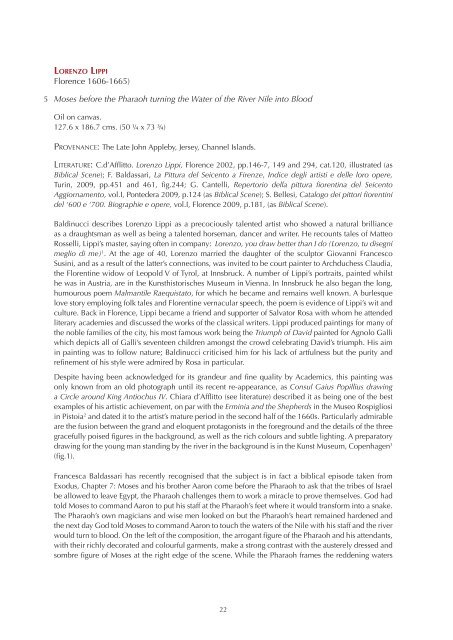Catalogue-2014-Jean-Luc-Baroni
- No tags were found...
Create successful ePaper yourself
Turn your PDF publications into a flip-book with our unique Google optimized e-Paper software.
Lorenzo Lippi<br />
Florence 1606-1665)<br />
5<br />
Moses before the Pharaoh turning the Water of the River Nile into Blood<br />
Oil on canvas.<br />
127.6 x 186.7 cms. (50 ¼ x 73 ¾)<br />
Provenance: The Late John Appleby, Jersey, Channel Islands.<br />
Literature: C.d’Afflitto. Lorenzo Lippi, Florence 2002, pp.146-7, 149 and 294, cat.120, illustrated (as<br />
Biblical Scene); F. Baldassari, La Pittura del Seicento a Firenze, Indice degli artisti e delle loro opere,<br />
Turin, 2009, pp.451 and 461, fig.244; G. Cantelli, Repertorio della pittura fiorentina del Seicento<br />
Aggiornamento, vol.I, Pontedera 2009, p.124 (as Biblical Scene); S. Bellesi, Catalogo dei pittori fiorentini<br />
del ‘600 e ‘700. Biographie e opere, vol.I, Florence 2009, p.181, (as Biblical Scene).<br />
Baldinucci describes Lorenzo Lippi as a precociously talented artist who showed a natural brilliance<br />
as a draughtsman as well as being a talented horseman, dancer and writer. He recounts tales of Matteo<br />
Rosselli, Lippi’s master, saying often in company: Lorenzo, you draw better than I do (Lorenzo, tu disegni<br />
meglio di me) 1 . At the age of 40, Lorenzo married the daughter of the sculptor Giovanni Francesco<br />
Susini, and as a result of the latter’s connections, was invited to be court painter to Archduchess Claudia,<br />
the Florentine widow of Leopold V of Tyrol, at Innsbruck. A number of Lippi’s portraits, painted whilst<br />
he was in Austria, are in the Kunsthistorisches Museum in Vienna. In Innsbruck he also began the long,<br />
humourous poem Malmantile Raequistato, for which he became and remains well known. A burlesque<br />
love story employing folk tales and Florentine vernacular speech, the poem is evidence of Lippi’s wit and<br />
culture. Back in Florence, Lippi became a friend and supporter of Salvator Rosa with whom he attended<br />
literary academies and discussed the works of the classical writers. Lippi produced paintings for many of<br />
the noble families of the city, his most famous work being the Triumph of David painted for Agnolo Galli<br />
which depicts all of Galli’s seventeen children amongst the crowd celebrating David’s triumph. His aim<br />
in painting was to follow nature; Baldinucci criticised him for his lack of artfulness but the purity and<br />
refinement of his style were admired by Rosa in particular.<br />
Despite having been acknowledged for its grandeur and fine quality by Academics, this painting was<br />
only known from an old photograph until its recent re-appearance, as Consul Gaius Popillius drawing<br />
a Circle around King Antiochus IV. Chiara d’Afflitto (see literature) described it as being one of the best<br />
examples of his artistic achievement, on par with the Erminia and the Shepherds in the Museo Rospigliosi<br />
in Pistoia 2 and dated it to the artist’s mature period in the second half of the 1660s. Particularly admirable<br />
are the fusion between the grand and eloquent protagonists in the foreground and the details of the three<br />
gracefully poised figures in the background, as well as the rich colours and subtle lighting. A preparatory<br />
drawing for the young man standing by the river in the background is in the Kunst Museum, Copenhagen 3<br />
(fig.1).<br />
Francesca Baldassari has recently recognised that the subject is in fact a biblical episode taken from<br />
Exodus, Chapter 7: Moses and his brother Aaron come before the Pharaoh to ask that the tribes of Israel<br />
be allowed to leave Egypt, the Pharaoh challenges them to work a miracle to prove themselves. God had<br />
told Moses to command Aaron to put his staff at the Pharaoh’s feet where it would transform into a snake.<br />
The Pharaoh’s own magicians and wise men looked on but the Pharaoh’s heart remained hardened and<br />
the next day God told Moses to command Aaron to touch the waters of the Nile with his staff and the river<br />
would turn to blood. On the left of the composition, the arrogant figure of the Pharaoh and his attendants,<br />
with their richly decorated and colourful garments, make a strong contrast with the austerely dressed and<br />
sombre figure of Moses at the right edge of the scene. While the Pharaoh frames the reddening waters<br />
22
















